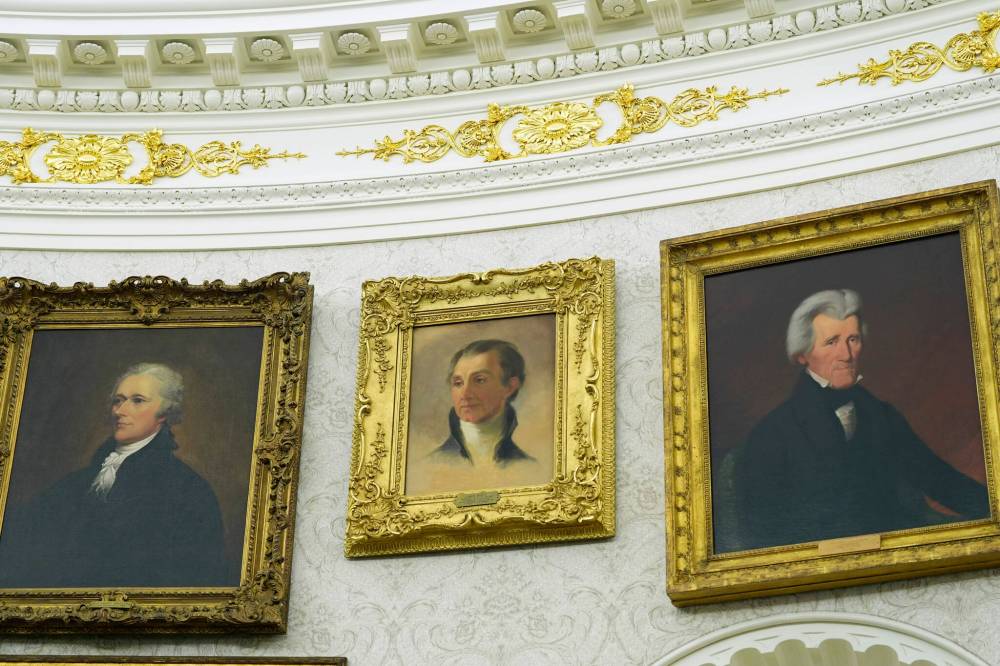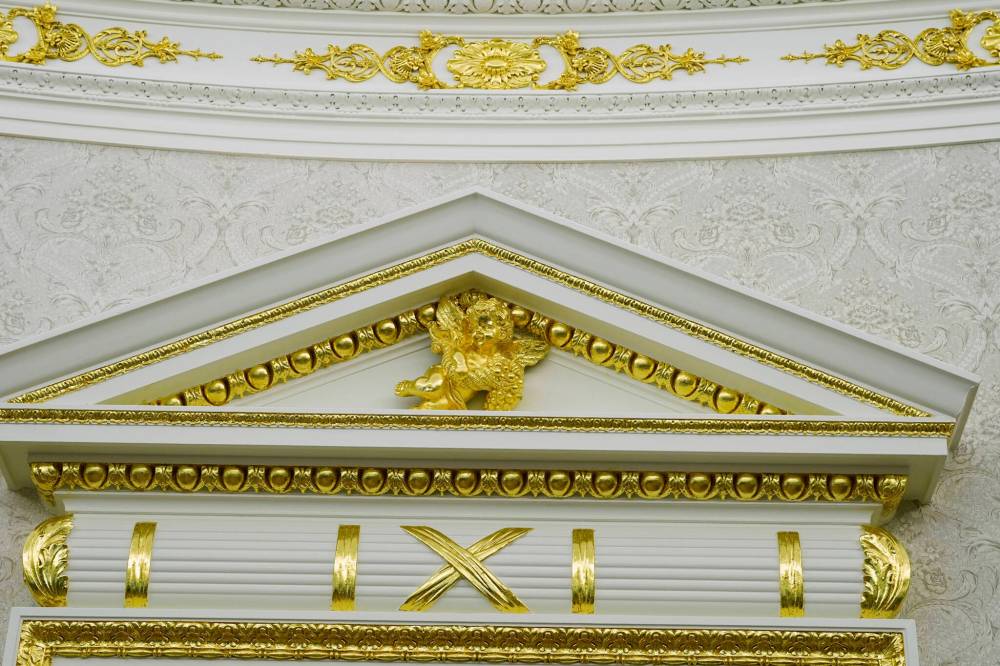Gilded to the hilt
Oval Office overhaul reflects Trump’s more-is-more m.O.
Advertisement
Read this article for free:
or
Already have an account? Log in here »
To continue reading, please subscribe:
Monthly Digital Subscription
$1 per week for 24 weeks*
- Enjoy unlimited reading on winnipegfreepress.com
- Read the E-Edition, our digital replica newspaper
- Access News Break, our award-winning app
- Play interactive puzzles
*Billed as $4.00 plus GST every four weeks. After 24 weeks, price increases to the regular rate of $19.00 plus GST every four weeks. Offer available to new and qualified returning subscribers only. Cancel any time.
Monthly Digital Subscription
$4.75/week*
- Enjoy unlimited reading on winnipegfreepress.com
- Read the E-Edition, our digital replica newspaper
- Access News Break, our award-winning app
- Play interactive puzzles
*Billed as $19 plus GST every four weeks. Cancel any time.
To continue reading, please subscribe:
Add Winnipeg Free Press access to your Brandon Sun subscription for only
$1 for the first 4 weeks*
*$1 will be added to your next bill. After your 4 weeks access is complete your rate will increase by $0.00 a X percent off the regular rate.
Read unlimited articles for free today:
or
Already have an account? Log in here »
WHAT IT IS: Donald Trump, like American presidents before him, has redecorated the Oval Office to reflect his own tastes. Depending on your politics, this “extreme goldening,” as it’s been called, is either Trump being Trump or a would-be Sun King demanding a backdrop of extravagant, pseudo-baroque excess.
WHAT IT’S ABOUT: When I was an art history student, one of my professors started his course in visual semiotics by lamenting the design of what was then the newly built Toronto Police Headquarters, which used glass bricks in its facade. Didn’t the architects realize glass bricks were associated with the architecture of Italian fascism, he asked. Why would they want to connect the city’s police force to a repressive regime?
My prof had wildly overestimated the average Torontonian’s interest in Mussolini modern, but his point still stands. The design of buildings, inside and out, carries historical associations, and those associations convey meanings.

So, what is the meaning of Trump’s maximalist makeover of the Oval Office?
To denounce it as vulgar, tacky or gaudy — musician Jack White compared it to “a pro wrestling dressing room” — is partly an esthetic stance, and it’s no surprise that lovers of, say, Scandinavian modernism would object to the new decor. Different people like different things, after all.
But other attacks hint at something deeper. When commentators describe the Oval Office rebrand as “robber baron with a dash of dictator,” “Temu Versailles” or “a gilded rococo hellscape,” they’re going beyond the issue of what is and isn’t considered good taste.
They’re suggesting that the problem with all the elaborate gold-leafed furbelows now bedecking the Oval Office comes down to their historical connotations: Trump’s favoured look is associated not with democracy but with absolutist monarchies and authoritarian rule.
According to this argument, Trump’s love of wall-to-wall gold is one thing at Mar-a-Lago, the president’s private Palm Beach club. In one of the most iconic spaces of American government, however, it’s much more loaded.
The White House, built from 1792 to 1800, is a neoclassical structure. Over the decades, its interior spaces have cycled through various revival styles and some idiosyncratic presidential preferences — Teddy Roosevelt adored taxidermy! — but much of its design draws on what is called the Federal Style. Coming out of the American Revolution, this movement, allied with neoclassicism, was an explicit rejection of the styles associated with the powerful kings and decadent aristocratic courts of Europe.
Calling back to the ideals of democratic Athens and Republican Rome, America’s new style was comparatively sober and simple. It favoured rational, more rectilinear forms, balanced symmetry and restrained proportions. Decorative details like ceiling medallions, cornices and moulding might be intricate but they were not overwhelming.
With Trump’s more-is-more approach to interior decorating, he seems to be suggesting that the Federal Style, with its often plain lines and muted colours, is for losers.
Trump’s touchstones instead include French baroque, which flaunts the grandeur of absolute power and the lavishness of opulent wealth. This style found perfect expression in Louis XIV’s Versailles, where three long avenues converged on the monarch’s bedchambers, physically proclaiming him the centre of the nation. (“L’État, c’est moi.”)
Meanwhile, Trump’s seeming horror of empty space — he has attached proliferating gold embellishments to walls and doors and hung numerous paintings in ornate gilded frames, along with two gilt-encrusted mirrors — nods vaguely toward the rococo. (One dismayed specialist has asked commentators to stop using this label because it’s giving actual rococo a bad name.) Rococo interiors, which used elaborate and all-encompassing decorative schemes, were popular among French aristocrats in those pre-guillotine years before the 1789 Revolution.

The final piece in Trump’s design puzzle might come from Dictator Style, a darkly funny 2006 book by Peter York. In surveying the presidential palaces and fortified compounds of autocratic regimes across the globe, York found several commonalities. Most despots like the pedigree of old styles but at the same time don’t want anything as shabby as real antiques. Instead, they replicate — often inaccurately — historical forms, in ways that are as new and shiny and fancy as possible. And they love, love, love gold.
According to York: “‘If I’ve only got one life,’ most dictators seem to think, ‘let me live it surrounded by gold.’”
WHY IT MATTERS: It’s important to remember that while a building’s design can express lofty ideals, the inhabitants of that building don’t always live up to them. Despite the Federal Style’s democratic associations, plenty of oppressive and unjust laws have been enacted and upheld under pure and plain neoclassical archways. The White House itself was built, in part, by the labour of enslaved people.
Still, the fact that Trump is not even attempting to uphold the Oval Office’s tradition of democracy-coded design but is instead plastering the room with the gold-leafed aggrandizement of power and wealth seems problematic.
Many of Trump’s supporters like that about him. He is what he is, they say. But if the president’s New Gilded Age ends up resembling the original 19th-century one — with enormous affluence for the few and exploitation and inequality for the many — all those golden baubles might start to look tarnished.
alison.gillmor@freepress.mb.ca

Studying at the University of Winnipeg and later Toronto’s York University, Alison Gillmor planned to become an art historian. She ended up catching the journalism bug when she started as visual arts reviewer at the Winnipeg Free Press in 1992.
Our newsroom depends on a growing audience of readers to power our journalism. If you are not a paid reader, please consider becoming a subscriber.
Our newsroom depends on its audience of readers to power our journalism. Thank you for your support.

